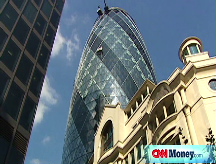Bonds in 2009: Waiting by the exits
Analysts say Treasurys may have a fast and furious decline this year when investors decide the time has come to test the stock market waters again.
NEW YORK (CNNMoney.com) -- Treasurys started 2009 on a down note Friday in the first trading day of the new year.
Government-issued bonds are coming off their best year since 1995, returning more than 13.7% to investors in 2008, but analysts say support for bonds could come to a crashing end in 2009.
Despite record bond auctions totaling hundreds of billions of dollars aimed at financing the government's bailouts, Treasurys were led higher by investor anxiety about the health of the overall economy and stock market.
But analysts expect the economy to begin its recovery sometime in 2009. They say stocks will rebound this year, restoring appetite for risk. That could mean a quick rush to the exits from what some analysts consider artificially high demand for Treasurys.
"Treasurys are overbought and perhaps in a bubble," said Kim Rupert, fixed income analyst with Action Economics. "When the mood changes, it will be a case of everybody out the door at the same time."
Rupert said a mass exodus from the bond market would be troubling for investors. As the value of their assets decline, they will have difficulty selling them off.
"The market will just explode, and you can just hope that you get out in time," she added.
Other analysts agree, saying growing government debt levels amid increasing appetite for risk could spell trouble for the bond market.
"Investor appetite for government debt has kept funding rates impressively low, but continued appetite is a potential concern in 2009," said Thomas Lee, a strategist for JPMorgan. "We believe investors are beginning to appreciate that risk aversion has hit maximum levels."
Lee expects the federal government's debt to balloon past the current $10 trillion level on further bailout actions. Investors' desire to buy up even more Treasurys will be tested as supply continues to expand, with more record bond auctions set to finance the financial rescue programs, he said.
But some analysts believe demand for bonds will remain, even if risk appetite increases.
Goldman Sachs analyst David Kostin said in a recent note that he expects the 10-year Treasury yield to increase to 3.6% from 2.67% to close 2008. That's a decent increase, though barely back to the 3.91% yield at the beginning of 2008. He forecasts a yield of 1% for the 2-year bond, up from 0.76% at the end of last year.
Bond prices: Treasurys continued a furious decline that ended 2008 on Wednesday. The bond market was closed Thursday for New Year's Day.
The benchmark 10-year fell 1 12/32 to 112 5/32 and its yield rose to 2.36% from 2.22% from Wednesday. Prices and yields move in opposite directions.
The 30-year bond dropped 2 17/32 to 134 12/32 and its yield rose to 2.78% from 2.67%.
The 2-year bond was down 5/32 to 100 2/32 and its yield rose to 0.85% from 0.76%.
Meanwhile, the 3-month yield - widely considered a gauge of investor confidence - fell to 0.09% from 0.12%.
Lending rates: The 3-month Libor fell to 1.41% from 1.42% Wednesday, and the overnight Libor rate sank to 0.12% from 0.14%, according to Dow Jones. The British Bankers' Association did not disclose Libor rates in observance of Thursday's bank holiday in the U.K.
Libor - the London Interbank Offered Rate - is a daily average of rates 16 different banks charge each other to lend money in London. It is used to calculate adjustable-rate mortgages. More than $350 billion in assets are tied to Libor.
Two market gauges were mixed to start the new year.
The "TED spread," a measure of banks' willingness to lend, slipped to 1.33 percentage points from 1.34 points - the lowest level for the measure since Sept. 11.
The lower the TED spread, the more willing investors are to take risks. The rate skyrocketed as the credit crisis took hold in mid-September, but it has fallen since the government put trillions of dollars into credit-easing programs in the past several months.
Another indicator, the Libor-OIS spread, rose to 1.29 percentage points from 1.24 points. The Libor-OIS spread measures how much cash is available for lending between banks, and is used for determining lending rates. The bigger the spread, the less cash is available for lending. ![]()




